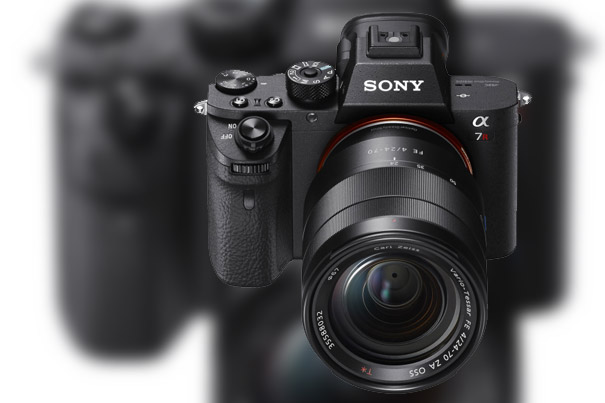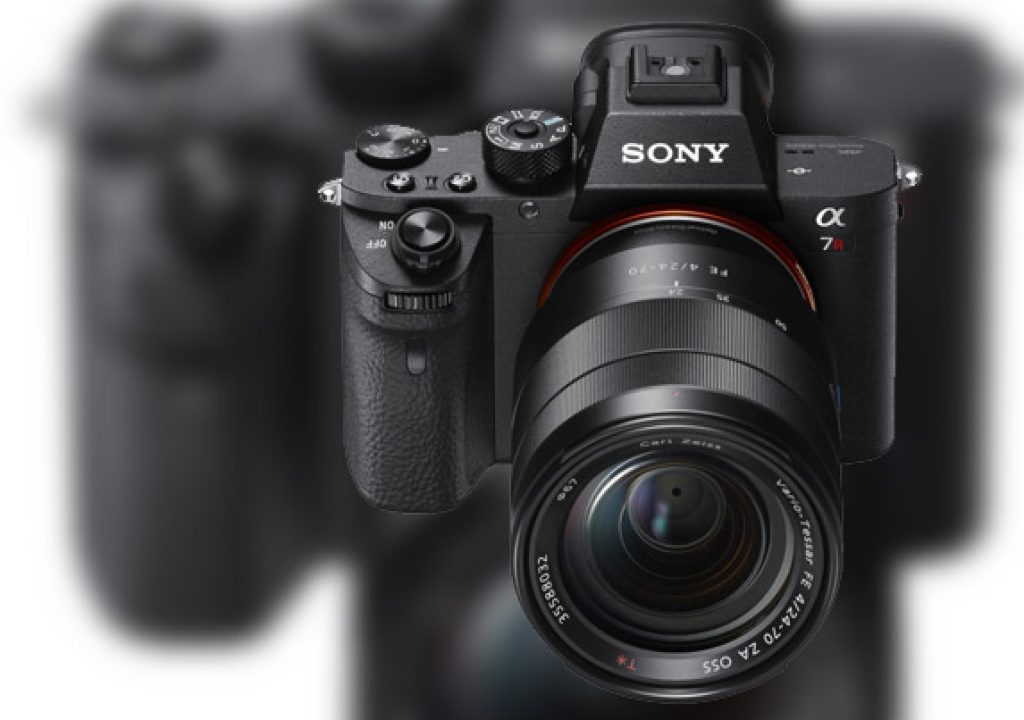
Sony introduced today their new flagship full-frame mirrorless camera, the α7R II, still named, inside Sony, as an interchangeable lens camera (ILCE-7RM2) but officially named, since a week ago, as Mirrorless.
Although it takes the shape of an old SLR externally, the new camera is not a DSLR, but a Mirrorless DSLR-like shaped. In fact, Sony has not made DSLRs since 2010. At the time Sony replaced the system inherited from Minolta in 2005 (or Konica-Minolta by then) with their SLT cameras. SLT stands for “single-lens translucent”, a semi-transparent mirror used in the image path instead of the normal mirror.
Although many refer to Sony as the creator of the system, the first cameras employing the pellicle mirror were created by Canon in 1960 (Canon Pellix), a technology used in different models from Canon but dropped years ago. Apparently Canon is returning to the technology in the future, although with a new implementation that will be interesting to see, as it may allow them to create smaller cameras in their EOS system.
First Back-Illuminated FF Sensor
Enough of this story, let’s look at the new Sony, which is the reason for these lines. The new α7R II interchangeable lens camera features the world’s first back-illuminated full-frame Exmor R CMOS sensor, which delivers high resolution (42.4 MP approx. effective megapixels), high sensitivity (expandable up to ISO 102400) when shooting still images.
The back-illuminated sensor in the α7R II is the result of continued investment by Sony in the development of this type of sensors, since 2009, when they introduced a 5 megapixel BI CMOS sensor at an acceptable price. Initially thought as only viable and interesting for small sensors, the back-illuminated technology, which offers better light capturing capability, has improved since then to the point we now see it in a full frame sensor.
Along the way that led them here, Sony developed, in 2012, a back-illuminated sensor further with Stacked CMOS, with the supporting circuitry placed below the active pixel section, giving a 30% improvement to light capturing capability.That same year they launched their sensor EXMOR RS with resolutions of 13 and 8 megapixels, using that technology. More recently, in 2014, Samsung showed the first APS-C sensor back-illuminated, on the NX1. Sony could not be left behind so now they have the first full frame sensor back-illuminated, the 42,4 megapixels sensor on the α7R II.
The newly developed 42.4 MP back-illuminated CMOS sensor is the most advanced, versatile and highest resolution full-frame image sensor that Sony has ever created, allowing the α7R II to reach new levels of quality, sensitivity and response speed, according to Sony. In the past, many photographers have been forced to choose between high-resolution and high-speed or high resolution and high sensitivity when selecting a camera. The new α7R II eliminates that sacrifice thanks to its innovative image sensor.
Data Moves 3.5X Faster
The 42.4 MP sensor combines gapless on-chip lens design and AR (anti-reflective) coating on the surface of the sensor’s glass seal to dramatically improve light collection efficiency, resulting in high sensitivity with low-noise performance and wide dynamic range. This allows the camera to shoot at an impressive ISO range of 100 to 25600 that is expandable to ISO 50 to 102400.
Additionally, the sensor’s back-illuminated structure, with an expanded circuit scale and copper wiring design, enables faster transmission speed and ensures content can be captured in high resolution without sacrificing sensitivity. Data can also output from the sensor at an approximately 3.5x faster rate compared to the original α7R.
The camera also includes a 5-axis image stabilization system borrowed from the α7 II model and can shoot and record 4K video in multiple formats including Super 35mm (without pixel binning) and full-frame format, a world’s first for digital cameras. Additionally, it has a newly refined XGA OLED Tru-Finder with the world’s highest (0.78x) viewfinder magnification amongst digital still cameras in June 2015, based on Sony’s research.. The viewfinder magnification is approx. 0.78x (with 50mm lens at infinity, -1m-1).
An ideal match for Sony’s extensive collection of FE lenses (35mm full-frame compatible E-mount lenses), the new α7R II features a high-speed BIONZ X image processing engine that allows images and video from the camera to be captured with supreme details and low noise. There is also no optical low pass filter on the camera, ensuring that scenery and landscapes are captured in the highest possible resolution and clarity.
AF 40% Faster
The α7R II has a new highly durable reduced-vibration shutter that delivers 50% less vibration from shutter movements compared to its predecessor, and has a cycle durability of approximately 500,000 shots (according to Sony internal testing, with the electronic front curtain shutter activated). The camera can also be set to Silent Shooting mode in order to shoot images quietly without any sensor vibration or movement.
The ability to capture moving subjects continues to be an area needing expansion in Mirrorless cameras, and Sony is moving forward with this model, as the information available confirms. The new image sensor features 399 focal-plane phase-detection AF points – the world’s widest AF coverage on a full-frame sensor – that work together with 25 contrast AF points to achieve focus response that is about 40% faster than the original model (remember the original was very slow. So these 40% are related to that…). The α7R II utilises an advanced motion-detection algorithm combined with this Fast Hybrid AF system to achieve up to 5fps continuous shooting with AF tracking.
Additionally, the focal plane phase-detection AF system on the α7R II works well with Sony A-mount lenses when they are mounted on the camera using an LA-EA3 or LA-EA1 mount adapter. This allows users to enjoy the wide AF coverage of 399 focal plane phase-detection AF points, high-speed response and high tracking performance with a wider range of lenses. This marks the first time that the AF system of a mirrorless camera can achieve high performance with lenses originally designed for DSLRs.
Here it is obvious Sony is admitting they need to expand their line of lenses urgently, even through adapters, to gather more interest in the system. It will be interesting to see if this convinces Canon and Nikon users to move on to a mirrorless system.
5-Axis Image Stabilization
The new flagship α7R II model is equipped with an innovative 5-axis image stabilization system that has been fine-tuned to support its high-resolution shooting capacity. Similar to the system launched on the acclaimed α7 II model, this advanced form of image stabilization corrects camera shake along five axes during shooting, including angular shake (pitch and yaw) that tends to occur with a telephoto lens, shift shake (X and Y axes) which becomes noticeable as magnification increases, and rotational shake (roll) that often affects video recording. This camera shake compensation system is equivalent to shooting at a shutter speed approximately 4.5 steps faster.
Additionally, the 5-axis stabilization works cooperatively with Sony α lenses with optical SteadyShot (OSS) to provide maximum stabilization and clarity, while also performing admirably via a compatible mount adapter with Sony α A-mount lenses without on-board stabilization. Effects of the stabilisation can be previewed via live-view on the LCD or OLED viewfinder of the camera.
4K Movie Shooting Performance
The impressive video credentials of Sony’s new α7R II camera include the ability to record movies in 4K quality (QFHD 3840×2160) in either Super 35mm crop mode or full-frame mode.
In Super 35mm mode, the camera collects a wealth of information from approximately 1.8x as many pixels as 4K by using full pixel readout without pixel binning and oversamples the information to produce 4K movies with minimal moire and ‘jaggies’.
In full-frame mode, the α7R II utilises the full width of the 35mm sensor for 4K recording, allowing users to utilise the expanded expressive power of the sensor. It is the world’s first digital camera to offer this in-camera full-frame format 4K recording capacity.
The camera utilises the advanced XAVC S codec during video shooting, which records at a high bit rate of 100 Mbps during 4K recording and 50 Mbps during full HD shooting. An SDXC memory card with a Class 10 or higher speed rating is required for XAVC S recording and UHS Speed Class 3 is required for recording at 100Mbps.
Additionally, the α7R II model features a variety of functions to support a professional video workflow including Picture Profile, S-Log2 Gamma and S-Gamut, 120fps high frame rate movie shooting in HD (720p), time code, clean HDMI output and more.
The new full-frame α7R II has an upgraded XGA OLED Tru-Finder with a double-sided aspherical lens that delivers the world’s highest viewfinder magnification of 0.78x for crystal clear image preview and playback across the entire display area. ZEISS T* Coating is also utilised to reduce unwanted reflections that interfere with the shooting experience.
The camera has an extremely solid, professional feel in-hand thanks to its light, rigid magnesium alloy design, and has a re-designed grip and shutter button compared to its predecessor. There is also a new mechanism to conveniently lock the mode dial, and an expanded range of customizable functions and buttons to suit the most demanding photographers.
The new α7R II camera is Wi-Fi and NFC compatible and fully functional with Sony’s PlayMemories Mobile application available for Android and iOS platforms, as well as Sony’s growing range of PlayMemories Camera Apps, which add a range of creative capabilities to the camera. For example, there is more creativity available now for time-lapse photography thanks to a new “Angle Shift add-on” app allows users to easily add pan, tilt and zoom to time-lapse images without any additional shooting equipment or PC software required. Learn more at www.sony.net/pmca.
Sony has also introduced a new LCD monitor model CLM-FHD5, an ideal companion to the α7R II for video shooting. A compact 5.0 type Full HD (1920x1080p) LCD monitor, the CLM-FHD5 features enlarging and peaking functionality for precise focusing, false color and video level marker for adjusting exposure and S-Log display assist to assist S-Log shooting.
The Sony α7R II full-frame interchangeable lens camera will be available in August for about $3200.



